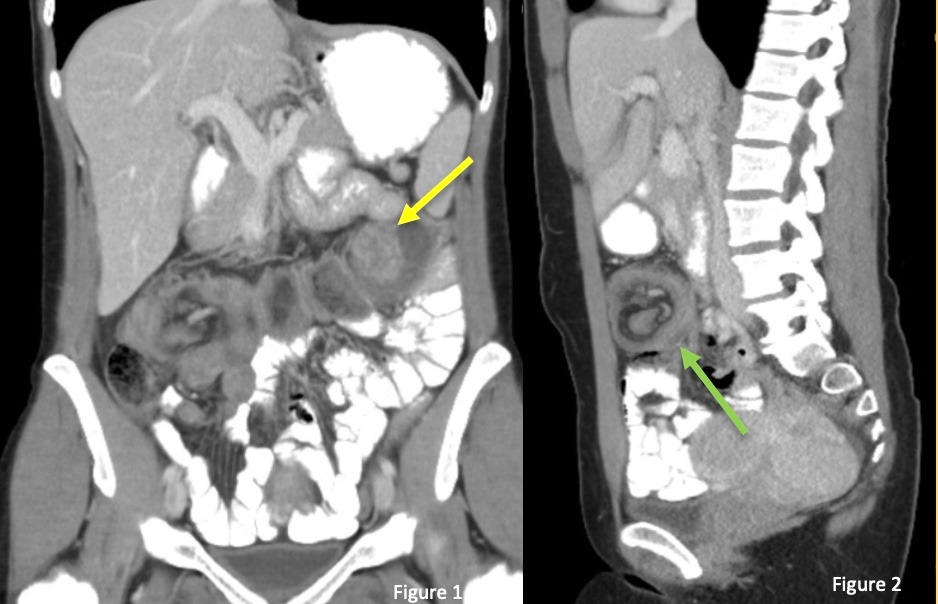Back
Poster Session E - Tuesday Afternoon
E0144 - Adult Intussusception: Finding a Lead on a Rare Case
Tuesday, October 25, 2022
3:00 PM – 5:00 PM ET
Location: Crown Ballroom

Paula A. Cacioppo, MD
Ochsner Clinic Foundation
Metairie , LA
Presenting Author(s)
Paula A. Cacioppo, MD1, Hooman Hajebian, MD2, Mohammad H. Zubaidi, MD3
1Ochsner Clinic Foundation, Kenner, LA; 2Ochsner Clinic Foundation, New Orleans, LA; 3Ochsner Clinic Foundation, Metairie, LA
Introduction: Bowel intussusception is defined as a telescoping proximal loop within the distal loop of bowel, obliterating the bowel lumen. Although over 95% of cases occur in the pediatric population; intussusception in adults is strongly associated with tumors, with malignancy rates accounting for approximately half of all adult cases.
Case Description/Methods: A 37-year-old female with no known past medical history presented to the Emergency Department complaining of suddenly worsening non-localized abdominal pain and distension. She reports a 5-day history of intermittent generalized cramps abdominal pain, which causes her to wake up several times throughout the night. Associated symptoms include anorexia, non-bloody emesis, and constipation, followed by small volume loose stools. Her physical exam was significant for generalized abdominal tenderness. Initial laboratory work-up with CBC, CMP, lipase and CRP were unrevealing except for a low serum bicarbonate (19). CT abdomen with contrast demonstrated a large colonic intussusception from the ascending colon to the splenic flexure, with suggestion of a large polyp or mass in the splenic flexure as a possible lead point, as seen in Figure 1 and Figure 2. The patient underwent an exploratory laparotomy with right hemicolectomy and lymphadenectomy. Pathology of the resected colon was consistent with a Plasmablastic neoplasm involving the ileocecal valve. All surgical margins and 27 resected lymph nodes were negative.
Discussion: Adult intussusception is a rare cause of bowel obstruction (< 1% on adult causes) that carries a high risk of complications, if not emergently identified and treated. Nonspecific abdominal pain is the most common clinical presentation of Adult Intussusception. The triad of red current jelly stool, colicky abdominal pain, and a palpable sausage-shaped mass; classically seen with children, is rarely present in the adult presentation. Due to high rates of malignancy, adult cases are traditionally treated with a large en-bloc resection. Early diagnosis of intussusception in adults requires a high level of clinical suspicion. Failing to recognize this may lead to complications such as bowel ischemia and perforation. Treatment in adults requires urgent operative management with oncologic resection and further investigation.

Disclosures:
Paula A. Cacioppo, MD1, Hooman Hajebian, MD2, Mohammad H. Zubaidi, MD3. E0144 - Adult Intussusception: Finding a Lead on a Rare Case, ACG 2022 Annual Scientific Meeting Abstracts. Charlotte, NC: American College of Gastroenterology.
1Ochsner Clinic Foundation, Kenner, LA; 2Ochsner Clinic Foundation, New Orleans, LA; 3Ochsner Clinic Foundation, Metairie, LA
Introduction: Bowel intussusception is defined as a telescoping proximal loop within the distal loop of bowel, obliterating the bowel lumen. Although over 95% of cases occur in the pediatric population; intussusception in adults is strongly associated with tumors, with malignancy rates accounting for approximately half of all adult cases.
Case Description/Methods: A 37-year-old female with no known past medical history presented to the Emergency Department complaining of suddenly worsening non-localized abdominal pain and distension. She reports a 5-day history of intermittent generalized cramps abdominal pain, which causes her to wake up several times throughout the night. Associated symptoms include anorexia, non-bloody emesis, and constipation, followed by small volume loose stools. Her physical exam was significant for generalized abdominal tenderness. Initial laboratory work-up with CBC, CMP, lipase and CRP were unrevealing except for a low serum bicarbonate (19). CT abdomen with contrast demonstrated a large colonic intussusception from the ascending colon to the splenic flexure, with suggestion of a large polyp or mass in the splenic flexure as a possible lead point, as seen in Figure 1 and Figure 2. The patient underwent an exploratory laparotomy with right hemicolectomy and lymphadenectomy. Pathology of the resected colon was consistent with a Plasmablastic neoplasm involving the ileocecal valve. All surgical margins and 27 resected lymph nodes were negative.
Discussion: Adult intussusception is a rare cause of bowel obstruction (< 1% on adult causes) that carries a high risk of complications, if not emergently identified and treated. Nonspecific abdominal pain is the most common clinical presentation of Adult Intussusception. The triad of red current jelly stool, colicky abdominal pain, and a palpable sausage-shaped mass; classically seen with children, is rarely present in the adult presentation. Due to high rates of malignancy, adult cases are traditionally treated with a large en-bloc resection. Early diagnosis of intussusception in adults requires a high level of clinical suspicion. Failing to recognize this may lead to complications such as bowel ischemia and perforation. Treatment in adults requires urgent operative management with oncologic resection and further investigation.

Figure: Figure 1. Coronal CT revealing large colonic intussusception with lead point (yellow arrow).
Figure 2. Sagittal CT demonstrating target sign (green arrow).
Figure 2. Sagittal CT demonstrating target sign (green arrow).
Disclosures:
Paula Cacioppo indicated no relevant financial relationships.
Hooman Hajebian indicated no relevant financial relationships.
Mohammad Zubaidi indicated no relevant financial relationships.
Paula A. Cacioppo, MD1, Hooman Hajebian, MD2, Mohammad H. Zubaidi, MD3. E0144 - Adult Intussusception: Finding a Lead on a Rare Case, ACG 2022 Annual Scientific Meeting Abstracts. Charlotte, NC: American College of Gastroenterology.
